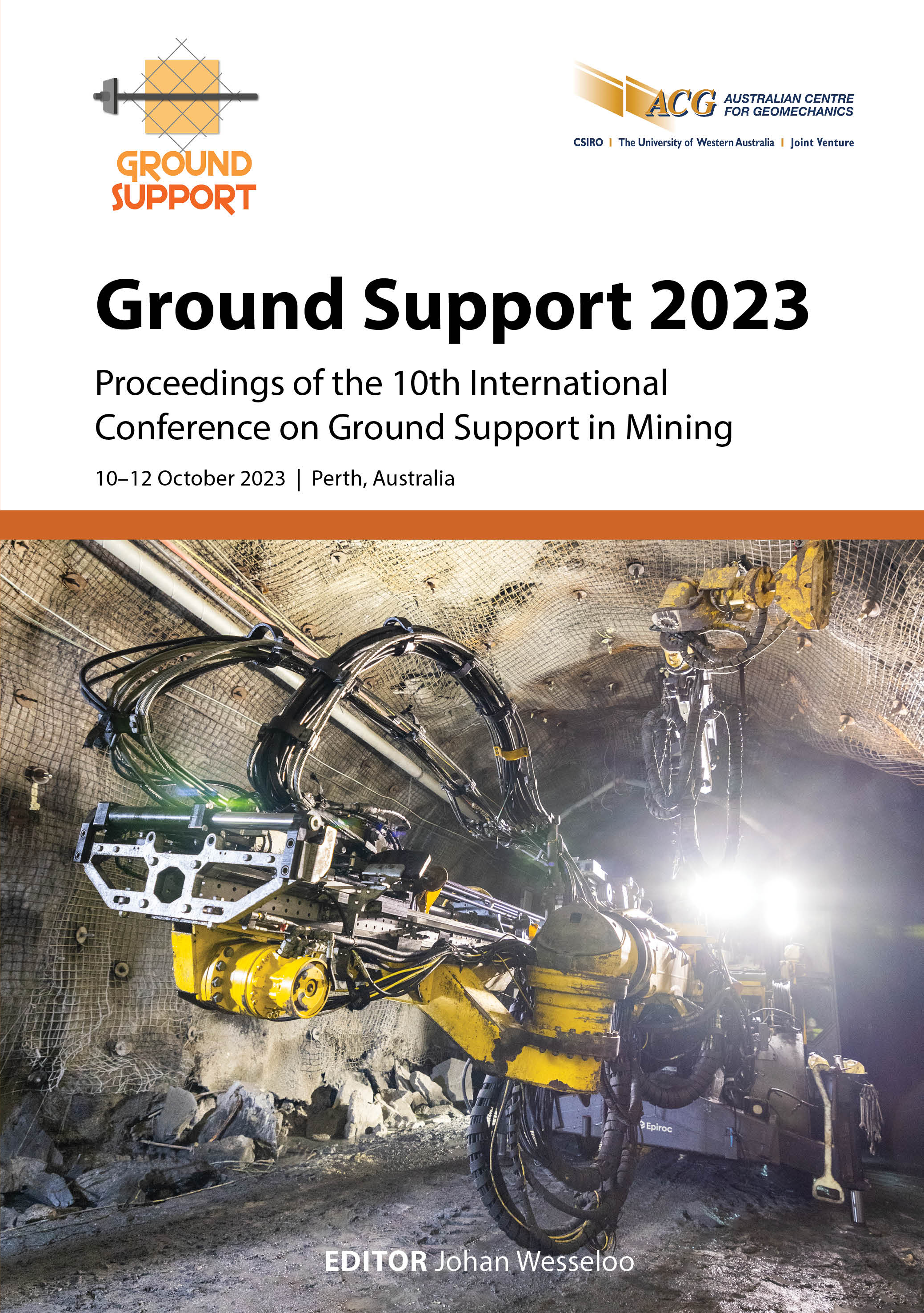A case study for rebar-reinforced shotcrete arches and void filling at the Grasberg Block Cave mine, Indonesia

|
Authors: Setiawan, A; Cahyono, B; Kriska, B; Ginting, R; Napitupulu, D |
DOI https://doi.org/10.36487/ACG_repo/2325_44
Cite As:
Setiawan, A, Cahyono, B, Kriska, B, Ginting, R & Napitupulu, D 2023, 'A case study for rebar-reinforced shotcrete arches and void filling at the Grasberg Block Cave mine, Indonesia', in J Wesseloo (ed.), Ground Support 2023: Proceedings of the 10th International Conference on Ground Support in Mining, Australian Centre for Geomechanics, Perth, pp. 647-658, https://doi.org/10.36487/ACG_repo/2325_44
Abstract:
The Grasberg block cave mine was developed below the Grasberg open pit at PT Freeport Indonesia as part of the transition to underground mining. The initial access drifts were developed in 2004 and production started in 2018, with a projected peak production of 160,000 t per day. During the development stage of the Drainage Drift 4, it became clear that the geological conditions would be a key parameter in the stability and sequence of these excavations. Where the lithological contact between the Faumai limestone and heavy sulphide zone (HSZ) coincided with the mid Grasberg fault zone, very poor ground conditions and short excavation stand up times lead to tunnel collapses and severe overbreak. Furthermore, a void was created due to the mucking operations. Void assessment using scan and drilling data was conducted to determine the void boundaries that would be concrete filled. A combination of spiling bars, rebar reinforced shotcrete arches (RRSA), and cable bolts were installed during the excavation process in these poor ground conditions. These ground support types and combinations, particularly the RRSA were designed to provide long-term stability for the excavations. This paper discusses the development of the various ground support strategies with reference to the RRSA including ground support capacity analysis.
Keywords: shotcrete arch, poor ground, development strategies, lithological contact, void
References:
American Concrete Institute 2019, Building Code Requirements for Structural Concrete (ACI 318-19), American Concrete Institute, Michigan.
Brannon, C, Beard, D, Pascoe, N & Priatna, A 2020, ‘Development of and production update for the Grasberg Block Cave mine – PT Freeport Indonesia’, in R Castro, F Báez & K Suzuki (eds), MassMin 2020: Proceedings of the Eighth International Conference & Exhibition on Mass Mining, University of Chile, Santiago, pp. 747–760,
Campbell, R, Banda, H, Fajar, J & Brannon, C 2018, ‘Optimising for success at the Grasberg Block Cave’, in Y Potvin & J Jakubec (eds), Caving 2018: Proceedings of the Fourth International Symposium on Block and Sublevel Caving, Australian Centre for Geomechanics, Perth, pp. 3–16,
Daniels, J & Roberts, R 1994, ‘Ground penetrating radar for geotechnical applications’, Geophysical Characterization of Sites, American Society of Civil Engineers ISSMFE#10 Publication on Geophysics, special volume XIII ICSFME, pp. 313–345.
Ekaputra, A 2018, Actual Geology Information GC2710L Drainage Drift 4 to North, Mid GRS Fault - Alteration Contact, internal report, PT Freeport Indonesia, Jakarta.
Karam, G & Tabbara, M 2009, ‘Hoek–Brown strength criterion for actively confined concrete’, Journal of Materials in Civil Engineering, vol. 21, no. 3, pp. 110–118.
Rubio, R, Fabregas, A & Fernandez, D 1998, ‘Underground mining drainage. state of the art’, Proceedings of International Mine Water Association Symposium, International Mine Water Association, Johannesburg, pp. 87–112.
Wight, JK & MacGregor, JG 2012, ‘Columns: combined axial load and bending’, in Reinforced Concrete Mechanics and Design, 6th edn, Pearson Prentice Hall, New Jersey, pp. 499–510.
© Copyright 2026, Australian Centre for Geomechanics (ACG), The University of Western Australia. All rights reserved.
View copyright/legal information
Please direct any queries or error reports to repository-acg@uwa.edu.au
View copyright/legal information
Please direct any queries or error reports to repository-acg@uwa.edu.au
